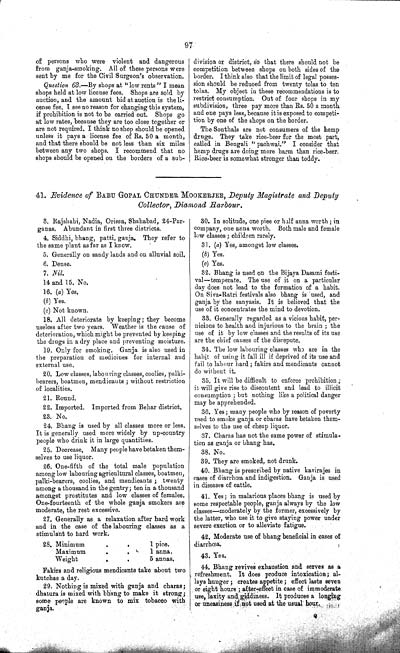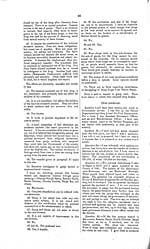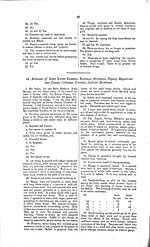Medicine - Drugs > Report of the Indian Hemp Drugs Commission, 1894-1895 > Volume IV
(111) Volume 4, Page 97
Thumbnail gallery: Grid view | List view

97
of persons who were
violent and dangerous
from ganja-smoking. All of these persons were
sent by me for the Civil Surgeon's observation.
shops held at low license fees. Shops are sold by
auction, and the amount bid at auction is the li-
cense fee. I see no reason for changing this system,
if prohibition is not to be carried out. Shops go
at low rates, because they are too close together or
are not required. I think no shop should be opened
unless it pays a license fee of Rs. 50 a month,
and that there should be not less than six miles
between any two shops. I recommend that no
shops should be opened on the borders of a sub-
division or district, so that there should not be
competition between shops on both sides of the
border. I think also that the limit of legal posses-
sion should be reduced from twenty tolas to ten
tolas. My object in these recommendations is to
restrict consumption. Out of four shops in my
subdivision, three pay more than Rs. 50 a month
and one pays less, because it is exposed to competi-
tion by one of the shops on the border.
The Sonthals are not
consumers of the hemp
drugs. They take rice-beer for the most part,
called in Bengali "pachwai." I consider that
hemp drugs are doing more harm than rice-beer.
Rice-beer is somewhat stronger than toddy.
41. Evidence of
BABU GOPAL CHUNDER MOOKERJEE, Deputy Magistrate and
Deputy
Collector, Diamond Harbour.
3. Rajshahi, Nadia,
Orissa, Shahabad, 24-Par-
ganas. Abundant in first three districts.
4. Siddhi, bhang,
patti, ganja. They refer to
the same plant as far as I know.
5. Generally on sandy lands and on alluvial soil.
6. Dense.
7. Nil.
14 and 15. No.
16. (a) Yes.
(b) Yes.
(c) Not known.
18. All deteriorate by keeping; they become
useless after two years.
Weather is the cause of
deterioration, which might be prevented by keeping
the drugs in a dry place and preventing
moisture.
19. Only for
smoking. Ganja is also used in
the preparation of medicines for internal and
external use.
20. Low classes,
labouring classes, coolies, palki-
bearers, boatmen, mendicants; without restriction
of localities.
21. Round.
22. Imported. Imported from Behar district.
23. No.
24. Bhang is used
by all classes more or less.
It is generally used more widely by up-country
people who drink it in large
quantities.
25. Decrease. Many
people have betaken them-
selves to use liquor.
26. One-fifth of
the total male population
among low labouring agricultural classes, boatmen,
palki-bearers, coolies, and mendicants; twenty
among a thousand in the gentry; ten in a thousand
amongst prostitutes and low classes of females.
One-fourteenth of the whole ganja smokers are
moderate, the rest excessive.
27. Generally as a
relaxation after hard work
and in the case of the labouring classes as a
stimulant to hard work.
|
28. Minimum 1 pice. |
|
Maximum 1 anna. |
|
Weight 5 annas. |
Fakirs and religious
mendicants take about two
kutchas a day.
29. Nothing is mixed
with ganja and charas;
dhatura is mixed with bhang to make it strong;
some people are known to mix tobacco with
ganja.
30. In solitude, one
pice or half anna worth; in
company, one anna worth. Both male and female
low classes; children rarely.
31. (a) Yes, amongst low classes.
(b) Yes.
(c) Yes.
32. Bhang is used on the Bijaya
Dasami festi-
val—temperate. The use of it on a particular
day does not lead to the formation of a habit.
On Siva-Ratri festivals also bhang is used, and
ganja by the sanyasis. It is believed that the
use of it concentrates the mind to
devotion.
33. Generally regarded as a
vicious habit, per-
nicious to health and injurious to the brain; the
use of it by low classes and the results of its use
are the chief causes of the
disrepute.
34. The low labouring classes who
are in the
habit of using it fall ill if deprived of its use and
fail to labour hard; fakirs and mendicants cannot
do without it.
35. It will be difficult to
enforce prohibition;
it will give rise to discontent and lead to illicit
consumption; but nothing like a political danger
may be apprehended.
36. Yes; many people who by
reason of poverty
used to smoke ganja or charas have betaken them-
selves to the use of cheap
liquor.
37. Charas has not the same power
of stimula-
tion as ganja or bhang has.
38. No.
39. They are smoked, not drunk.
40. Bhang is prescribed by native
kavirajes in
cases of diarrhœa and indigestion, Ganja is used
in diseases of cattle.
41. Yes; in malarious places
bhang is used by
some respectable people, ganja always by the low
classes—moderately by the former, excessively by
the latter, who use it to give staying power under
severe exertion or to alleviate
fatigue.
42. Moderate use of bhang
beneficial in cases of
diarrhœa.
43. Yes.
44. Bhang revives exhaustion and
serves as a
refreshment. It does produce intoxication; al-
lays hunger; creates appetite; effect lasts seven
or eight hours; after-effect in case of immoderate
use, laxity and giddiness. It produces a longing
or uneasiness if not used at the usual
hour.
Q
Set display mode to: Large image | Zoom image | Transcription
Images and transcriptions on this page, including medium image downloads, may be used under the Creative Commons Attribution 4.0 International Licence unless otherwise stated. ![]()
| India Papers > Medicine - Drugs > Report of the Indian Hemp Drugs Commission, 1894-1895 > Volume IV > (111) Volume 4, Page 97 |
|---|
| Permanent URL | https://digital.nls.uk/74552472 |
|---|---|
| Description | Evidence of Bengal witnesses. |
| Description | Volume 4: Evidence of witnesses from Bengal and Assam. |
|---|---|
| Attribution and copyright: |
|




